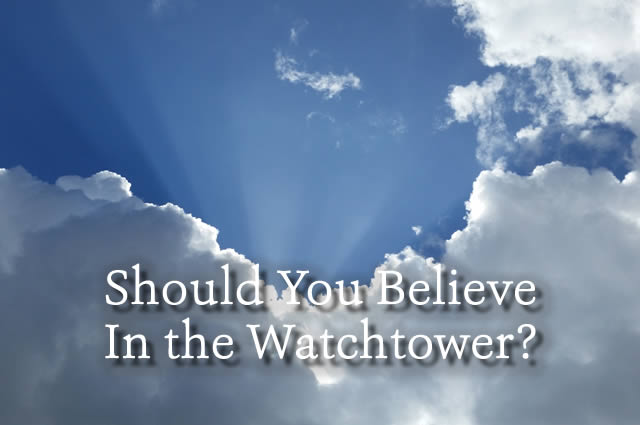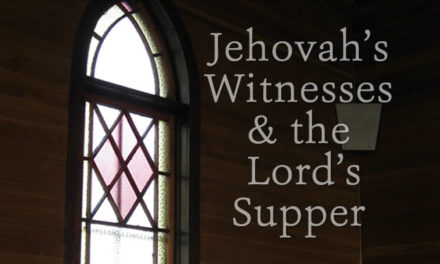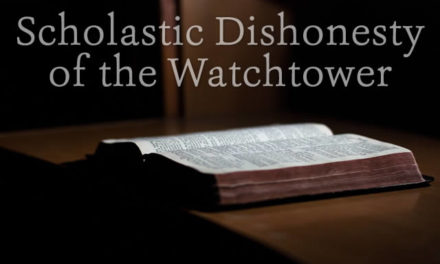The Jehovah’s Witness organization is the Watchtower Bible and Tract Society (WT). They maintain that God has only one organization on earth today, and they are it. Their claim that they are God’s “channel of communication” for our time is a heady one.
It is a claim that the WT has a corner on spiritual truth. It is a claim that only the WT can rightly interpret and explain Scripture. And it is a claim that the WT alone can provide godly direction and counsel for all the people on earth.
Any group can make such a claim. However, it is another matter to measure up to it. We are commanded to test those who make such claims (1 John 4:1). God has given us standards by which we can test teachers and prophets, and distinguish between the true and the false. That is the intent of this article.
EVALUATING FALSE PROPHETS
There are scriptural guidelines for evaluating claims like those of the WT (or any other religious group.) The Lord Jesus said that false prophets might be recognized by “bad fruit” or sinful deeds (Matt. 7:15-20). We would have to acknowledge that all people sin, even prophets. But a true prophet would not be characterized by a consistent pattern of deliberately spurning God’s law.
Therefore, anyone who claims to be a prophet should be reliably honest in all his dealings-especially in spiritual matters. The WT claims it is the “faithful and wise servant” called to dispense God’s “meat in due season” (see Matt. 24:45). Those whom God has called to be teachers and prophets must be circumspect about their proclamation (James 3:1). It must always be only the truth.
Jesus also said that false prophets deceive rather than enlighten (Matt. 24:11). One who deliberately and repeatedly distorts the truth would be disqualified as a true prophet. The apostle Peter taught that false prophets can be spotted because they fail the test of orthodoxy, and introduce heresies which deny Jesus as Lord (2 Pet. 2:1).
THE TRINITY AND THE DEITY OF CHRIST
Two well-established doctrines in the Bible are the Trinity and the full divinity of the Lord Jesus Christ. The reader should note that a well-developed case for the validity of these doctrines is beyond the scope of this article because of space limitations. However, since we are questioning the orthodoxy of the WT as God’s organization, it would be well to briefly make the case for these two doctrines.
Briefly, here is how the Bible conveys the doctrine of the Trinity. The Father is God (2 John 1:3; 1 Pet. 1:2-3), the Son is God (John 1:1; Rev. 1:7-8), and the Holy Spirit is God (Acts 5:3-4; 2 Cor. 3:17). Each of these Persons must be fully God, because to say otherwise would be to compromise the essential unity of God.
The Bible also clearly portrays the full deity of Jesus Christ. Everything that the Father is, the Son is also: Both are eternally unchanging (compare Mal. 3:6 and Heb. 3:8); both use the title “Lord” (compare Ps. 68:19 and Rom. 10:9); both are called “Lord of Lords” (compare Deut. 10:17 and Rev. 17:14); both are the only “Savior” (compare Isa. 45:21 and Acts 4:12); and it is said of both that every knee will bow and every tongue will confess their Lordship (compare Isa. 45:23 and Phil. 2:10-11).
These doctrines are not man-made. They are derived from the Bible. Those who challenge them are not challenging men, but the very word of God. Thus, anyone or any organization that teaches otherwise is engaging in heresy – the teaching of ideas that are in opposition to the clear teaching of what God has revealed in Scripture.
TESTING THE WATCHTOWER
Now we may return to the primary purpose of the article, to answer the question of whether the any group can be trusted to teach spiritual truth. The Bible gives us clear standards by which we can judge. The Bible is clear that an organization hearing from God would not deliberately and consistently mislead people, it would not distort the truth, and it would not teach heresy which denies Jesus as Lord.
So, how does the WT measure up? As a case study, we here will examine one of the WT’s most commonly distributed pamphlets. This pamphlet has been used by the WT since 1989, and thus Jehovah’s Witnesses cannot claim that it is new, and it will be corrected. If it is wrong, they have had ample opportunity to change it. If it is in error, it represents a consistent and intentional pattern of deception.
The pamphlet in question is an attack on one of the Bible’s most important and fundamental doctrines. The title is Should You Believe in the Trinity? (1) The pamphlet seems very authoritative. Quotations from non-WT and even evangelical Christian sources make it appear as though the doctrine of the Trinity is, in reality, unbiblical, and that even our own pastors and teachers don’t really believe it.
However, as the reader will see, the WT repeatedly misquotes publications and authors, taking out of context in a number of places in order to make a case for the heresy of denying the Trinity, and thus denying the full Lordship of Jesus Christ. What follows are four examples of these distortions.
TRINITARIAN THEOLOGY UNREASONABLE?
Firstly, the pamphlet quotes The Encyclopedia Americana on page 4: “The doctrine of the Trinity is considered to be ‘beyond the grasp of human reason.'”
However, in its fuller context, The Encyclopedia Americana actually says, “It is held that although the doctrine is beyond the grasp of human reason, not contrary to reason, and may be apprehended (though it may not be comprehended) by the human mind.” (2)
This passage was taken out of context to add credibility to the WT teaching that the Trinity is an “unreasonable” doctrine. However, even the WT admits that just because a doctrine seems incomprehensible, that is no reason to reject it: “Should we really expect to understand everything about a Person who is so great that he could bring into existence the universe, with all its intricate design and stupendous size?” (3)
TRINITARIAN THEOLOGY NOT BIBLICAL?
Secondly, the pamphlet quotes from The New International Dictionary of New Testament Theology (NIDNTT) twice on page 6. The first of the two quotations says, “The N[ew] T[estament] does not contain the developed doctrine of the Trinity. ‘The Bible lacks the express declaration that the Father, the Son, and the Holy Spirit are of equal essence’ [said professor Karl Barth].”
This would make it appear that the author of this article in NIDNTT, J. Schneider, does not believe that the New Testament teaches the doctrine of the Trinity. However, the WT fails to note that earlier in the same article; the author declares that Christ is God. He says, “Jesus’ words of self-disclosure in statements using the divine ‘I am’ formulae… which in the O[ld] T[estament] are self-revelations of God Himself.” (4)
Schneider continues, “Several passages in Jn. contain ascriptions of divinity. Jn. 1:1 (RSV) declares: ‘In the beginning was the Word, and the Word was with God, and the Word was God…'” (5)
He goes on to say: Jn. 20:28 contains the unique affirmation of Thomas in addressing the Risen Christ as God: “My Lord and my God…” The statement marks the climax of the Gospel. God has become visible for Thomas in the form of Jesus. The climax of Johannine teaching occurs in the confessional formula of 1 Jn. 5:20 which asserts the full identity of essence of Christ and God. (6)
The other out-of-context quotation from NIDNTT is also from an article written by Schneider: “Primitive Christianity did not have an explicit doctrine of the Trinity such as was subsequently elaborated in the creeds.”
But again, Schneider is not saying that the Trinity is a doctrine introduced later, and is therefore unbiblical. Quite the contrary, in another article in NIDNTT Schneider writes, “The virgin birth, according to the N[ew] T[estament], is the channel by which the eternally pre-existing Second Person of the Trinity entered as a truly human being…” (7)
Schneider does not deny the Trinity in the NIDNTT, Schneider is actually affirming it!
JESUS A CREATED BEING?
Thirdly, on page 7, the Should You? pamphlet quotes the church father Tertullian as having said, “There was a time when the Son was not…” The implication is that Tertullian (along with other church fathers prior to the Nicean Council in a.d. 325) did not believe in the Trinity, but instead saw Jesus as a created being, as the WT maintains.
However, even a casual study of Tertullian will reveal that this is incorrect. Tertullian believed that the Word, or Second Person of the Trinity, was eternally pre-existent. Only His title, “Son” was later added. In his famous defense of the doctrine of the Trinity, Against Praxeas, Tertullian wrote that Jesus was “both Man and God.” (8)
In fact, Tertullian is the one who coined the term, “Trinity!”
Further, he stated:
“While the mystery of the dispensation is still guarded, which distributes the Unity into a Trinity, placing in their order the three Persons-the Father, the Son, and the Holy Ghost: three, however, not in condition, but in degree; not in substance, but in form; not in power, but in aspect; yet of one substance, and of one condition, and of one power, inasmuch as He is one God, from whom these degrees and forms and aspects are reckoned, under the name of the Father, and of the Son, and of the Holy Ghost. How they are susceptible of number without division, will be shown as our treatise proceeds.” (9)
HERETICAL CONFUSION
Finally, the pamphlet repeatedly confuses the biblical doctrine of the Trinity with the ancient heresy of Modalism (or Sabellianism).
On page 3, the WT correctly states the doctrine of the Trinity, quoting from The Catholic Encyclopedia: “‘The Father is God, the Son is God, the Holy Spirit is God, yet there are not three Gods, but one God.’ In this Trinity…the Persons are co-eternal and co-equal…”
However, afterward, the pamphlet misrepresents the doctrine by substituting Modalism in place of orthodoxy. Modalism is the belief that there is one divine Person acting in three roles or modes.
The WT then “disproves” the Trinity by attacking the heresy of Modalism. They quote Tertullian (p. 7) as having said, “The Father is different from the Son…” The same fallacy occurs on page 17 under the heading “Jesus distinguished from God.”
All they prove is that the Father and the Son are not the same Person-which is one of the key aspects of the doctrine of the Trinity.
1 Watch Tower Bible and Tract Society of Pennsylvania, Should You Believe in the Trinity (Brooklyn: Watchtower Bible and Tract Society of New York, 1989).
2 Frederick C. Grant, “The Trinity,” Encyclopedia Americana (Danbury, CN: Americana Corp., 1980), Vol. 27, 116.
3 Watch Tower Bible and Tract Society of Pennsylvania, Reasoning from the Scriptures (Brooklyn: Watchtower Bible and Tract Society of New York, 1989), 148.
4 J. Schneider, “God, Gods, Emmanuel” The New International Dictionary of New Testament Theology (Grand Rapids: Zondervan, 1975) Vol. 2, 79-80.
5 Ibid., 81.
6 Ibid., 81-82.
7 Ibid., Vol. 3, 661.
8 Tertullian, “Against Praxeas” The Ante-Nicene Fathers: Translations of the Fathers down to A.D. 325, (Grand Rapids: Eerdmans, 1989), 598. 9 Ibid.
By Everett Shropshire






